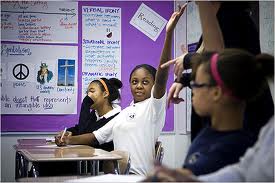Charter School Teaching: Similar to or Different from Regular Public Schools?
Since 1991 when Minnesota launched the first charter schools, the movement to create publicly funded charters freed from district rules where parents can choose to send their children has spread to 40 states (and the District of Columbia) enrolling almost two million students (nearly four percent of all public school students) in over 5,000 schools (over five percent of all public schools). Most charter schools are located in urban districts with one-quarter to one-third of all students enrolled in charters. In some cases such as New Orleans, the majority of children and youth attend charter schools.
The theory driving charter schools is that schools unchained from district policies (including union contracts) for three to five years would have legal, budgetary, and organizational autonomy to steer its own course and, through innovative changes, increase the quality of schooling. Moreover, charter schools would be held accountable to the market—parents and students choose to attend—and to stipulations in the charter itself to perform well academically and be fiscally responsible. If there were serious lapses, charter renewal would be forfeited (WP-01).
A flexible curriculum, eager teachers, parental choice, accountability, and public funding would combine to create innovative schools where a new organization, hard-working teachers using different pedagogies, and satisfied parents would add up to higher student achievement than would have occurred in regular public schools. That is the theory.
After two decades, charter schools continue to grow. Parental demand for choices in schools remains high. There is evidence that charter schools compared to regular ones differ in organizational practices (e.g., block scheduling, extended school day, teachers staying with same students two or more years; small group instruction). Yet, in the face of this growth in these publicly funded organizations, charter and regular teachers both say, given the theory driving charter schools, that they exert little influence over curriculum and instruction. That surprised me.
Because school reformers view teaching practices as predictors of student achievement, have teachers in charter school, freed from district rules and prescriptions, practiced their craft differently than their peers in public schools?
What evidence there is says that with even more autonomy and flexibility for teachers in charter schools there is little difference between their classroom practices and peers in public schools. Researchers who examined studies of pedagogy across charter and non-charter schools concluded that
“as charter schools implement innovations in governance, management, and other organizational practices, charter schools are embracing curricular and instructional approaches already in use (original italics) in other public schools that are considered as traditional ‘basic’ approaches to instruction” (Goldring-Cravens_2006).
Such findings leave holes in the theory embedded in charter schools. Like their counterparts in regular public schools, charter school teachers mainly use teacher-centered classroom practices such as lectures, scripted lessons, textbooks, worksheets, homework, question/answer/evaluation exchanges seasoned by certain student-centered practices such as small group work, student discussions, project-based learning, internships, and independent learning.
Keep in mind that when I use the phrase “teacher-centered” and “student-centered” instruction I do not infer that such teaching practices are either appropriate or inappropriate, effective or ineffective. I am reporting what many researchers, including myself, have documented in classrooms.
When one looks at Knowledge is Power Program (KIPP) where all 109 elementary and secondary schools in 20 states serving over 30,000 students are charters, teaching approaches are unmistakably teacher-centered. KIPP is not, of course, representative of all charter schools in its teaching practices. Aspire, Green Dot, and other charter management organizations have schools in their networks where teaching practices vary considerably but still work within the tradition of teacher-centeredness.
Note that these elementary and secondary school charters are geared to preparing children and youth for college. That is their unvarnished mission. College prep begins early in these charter elementary and secondary schools; frontal teaching, direct instruction, extended day, and no-nonsense approaches to student behavior are the norm. So any variation among teachers in different networks of charter schools falls within a narrow band of teacher-centered practices—again when I use that phrase I do not suggest that such practices are either appropriate nor inappropriate, either effective nor ineffective.
This blog post has been shared by permission from the author.
Readers wishing to comment on the content are encouraged to do so via the link to the original post.
Find the original post here:
The views expressed by the blogger are not necessarily those of NEPC.


